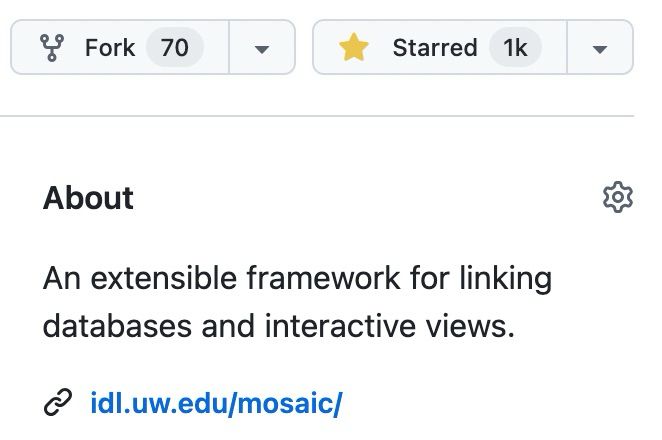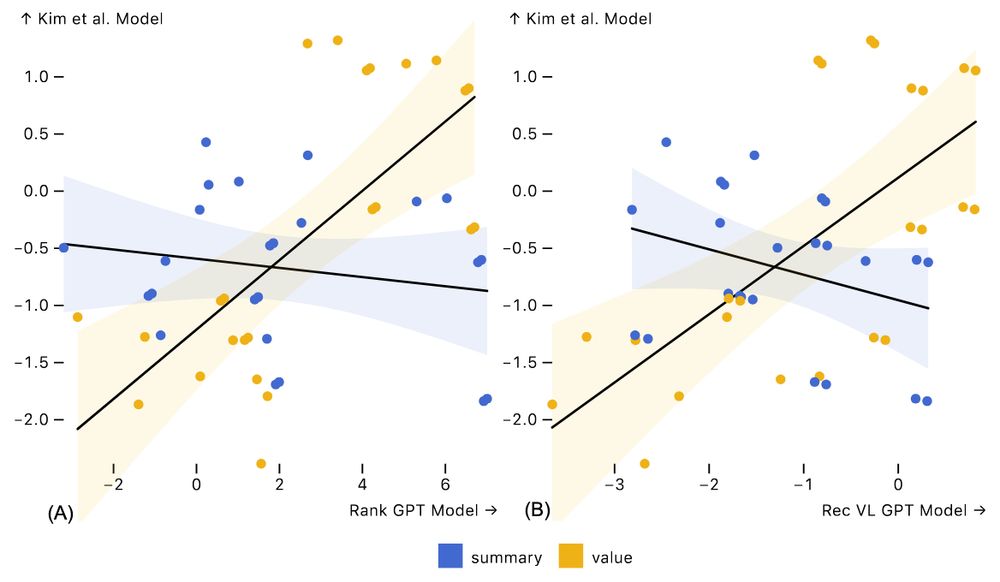
Screenshot from GitHub showing 1k stars for the Mosaic project, an extensible framework for linking database and interactive views.
The Mosaic architecture for database-backed interactive visualization just hit 1,000 stars on GitHub! Thank you to all who have participated and contributed!
29.04.2025 18:04 — 👍 31 🔁 2 💬 0 📌 2
DracoGPT was led by Will Wang, in collaboration with Mitchell Gordon, Leilani Battle, and @jheer.org. For more, see the VIS'24 paper "DracoGPT: Extracting Visualization Design Preferences from Large Language Models" idl.uw.edu/papers/draco...
26.11.2024 19:12 — 👍 1 🔁 0 💬 0 📌 0
For value comparison tasks, GPT-4 Turbo mostly aligns with human performance data. But for summary tasks, the GPT responses are uncorrelated and likely unhelpful! This may be due to much research and punditry on value comparison, but less attention to aggregate perception, biasing LLM training data.
26.11.2024 19:12 — 👍 1 🔁 0 💬 1 📌 0

Chart costs conditioned on task type, comparing Kim et al.’s experimental results to DracoGPT-Rank (A) and DracoGPT-Recommend Vega-Lite (B). For value tasks, results from both GPT4-Turbo models moderately correlate with a model fit to human performance data, but do not significantly correlate for summary tasks.
We applied DracoGPT using experimental data from Younghoon Kim et al. (EuroVis'18) that spans a variety of plots, data distributions, and tasks (comparing individual values vs. aggregate properties). The plots show chart "scores" from two GPT-4 Turbo prompting methods vs. human performance data.
26.11.2024 19:12 — 👍 0 🔁 0 💬 1 📌 0
DracoGPT prompts an LLM to rank or recommend charts, and uses the results to create new training pairs. It then learns constraint weights to model the design preferences expressed by the LLM. We can compare different fitted knowledge bases to see how their design choices align or diverge.
26.11.2024 19:12 — 👍 0 🔁 0 💬 1 📌 0
Draco represents visualizations as a set of facts (about data & encodings) and constraints (preferences about encodings, scales, etc - such as if a bar chart has a zero baseline). From labeled chart pairs, we learn constraint weights ("costs") that balance competing constraints to "score" a chart.
26.11.2024 19:12 — 👍 0 🔁 0 💬 1 📌 0

Overview of the DracoGPT-Rank pipeline. (1) User provides prompt templates for an LLM to rank chart pairs; (2) Draco featurizes charts and produces feature vectors consisting of constraint counts; (3) Draco learns constraint weights over LLM-labeled chart pairs by fitting a RankSVM model; (4) The fitted Draco model can be applied to score charts. Results at each stage of the pipeline afford insight into LLM ranking preferences.
People are now using LLMs to create charts and graphs. How might we assess the quality and consistency of the results? DracoGPT is a method that fits a visualization knowledge base (Draco) to LLM responses, enabling comparison across models, prompts, and results from human subjects experiments.
26.11.2024 19:12 — 👍 17 🔁 2 💬 1 📌 1
👋
26.11.2024 00:16 — 👍 1 🔁 0 💬 0 📌 0
Hi Bluesky! 👋 We’re the Interactive Data Lab at UW. We’ll post about data visualization, analysis, and human-computer interaction research, as well as open source projects. Over the years we’ve been involved with Protovis, D3, Data Wrangler (-> Trifacta), Vega/Vega-Lite, Mosaic, and other projects!
25.11.2024 17:37 — 👍 33 🔁 2 💬 3 📌 2
We are the hub for data science and AI research collaboration at the University of Washington.
https://linktr.ee/escienceinstitute
Asst prof @ UCLA CS. Programming tools for scientists!
Usually doing some combo of HCI + data science + PL.
Always drinking or dreaming about tea (or tea-lang.org, tisane-stats.org).
The world's premier forum for advances in visualization and visual analytics. https://ieeevis.org/year/2024/welcome
Breakthrough AI to solve the world's biggest problems.
› Join us: http://allenai.org/careers
› Get our newsletter: https://share.hsforms.com/1uJkWs5aDRHWhiky3aHooIg3ioxm
Incoming assistant prof at MIT CSAIL, CS PhD from Stanford. HCI, human-AI interaction, social computing.
Member of Technical Staff @OpenAI | Teaching the machines to learn from humans.
Google Scholar: https://scholar.google.com/citations?user=BH7jpGIAAAAJ&hl=en
Data visualization, color science
FGV Professor. Data Visualization, Data Science, Machine Learning
Our mission: map and assess the world's sidewalks using remote crowdsourcing, artificial intelligence, and online satellite & streetscape imagery. Let's make the world more walkable, rollable, and bikeable! Join us: https://projectsidewalk.org/
Center for Research and Education on Accessible Technology and Experiences at the University of Washington. CREATE's mission is to make technology accessible and to make the world accessible through technology.
PhD student in CS at UC Berkeley
joshuahhh.com
t-shirt size: medium
We are a research group at the Human-Computer Interaction Institute at Carnegie Mellon University (@hcii.cmu.edu). Our mission is to empower everyone to analyze and communicate data with interactive systems.
The NLP group at the University of Washington.
The Paul G. Allen School of Computer Science & Engineering at the University of Washington educates tomorrow's innovators while developing solutions to humanity's greatest challenges.
Into creative ML/AI, NLP, data science and digital humanities, narrative, infovis, games, sf & f. Consultant, ds in Residence at Google Arts & Culture. (Lyon, FR) Newsletter arnicas.substack.com.



